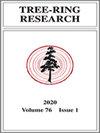A Case Study: Growth of Tree-Form Willow Driven by Cool, Wet Springs and Warm, Dry Summers in Teetł'it Zheh (Fort Mcpherson), Northwest Territories, Canada
IF 1.1
4区 农林科学
Q3 FORESTRY
引用次数: 0
Abstract
Willow trees (Salix alaxensis) growing along the Peel River floodplains near Teetł'it Zheh (Fort McPherson), Northwest Territories, Canada, have been identified as a species of interest because of their impressive height and novel growth form. These willow stands are characterized by tree-form individuals covering 2000–3000 ha. Little research has been directed at understanding the climate–growth relationships of willow in this growth form or region. In this case study, we evaluate the dendrochronological potential of these willows, and assess climate–growth relationships for monthly temperature, precipitation, and SPEI (Standardised Precipitation Evapotranspiration Index) variables. We found that individual trees exhibited a common stand-level pattern of growth variability. Climate–growth correlation analyses indicate willow growth is positively related to May SPEI (r = 0.392) and the mean of June and July maximum temperature (r = 0.341). Willow growth exhibited a negative relationship with May maximum temperature (r = -0.458) and mean June/July SPEI (r = -0.338). These findings suggest there is a general climate response, where willow growth is greater in years with cool, wet springs, and warm, dry summers. Our results provide the first documentation of climate–growth relationships for willow in tree growth form and provide promising preliminary uses of tree-form Salix spp. for dendrochronological analyses.案例研究:加拿大西北地区teetzoit Zheh (Fort Mcpherson)凉爽潮湿的春天和温暖干燥的夏天对树形柳树生长的影响
柳树(Salix alaxensis)生长在加拿大西北地区teetz 'it Zheh (Fort McPherson)附近的皮尔河洪泛区,由于其令人印象深刻的高度和新颖的生长形式,已被确定为一种有趣的物种。这些柳树林的特点是树形个体,占地2000-3000公顷。很少有研究是针对了解这种生长形式或地区的柳树的气候生长关系。在本案例研究中,我们评估了这些柳树的树年代学潜力,并评估了月温度、降水和标准化降水蒸散指数(SPEI)变量的气候-生长关系。我们发现单个树木表现出一个共同的林分水平的生长变异性模式。气候-生长相关分析表明,柳木生长与5月SPEI (r = 0.392)和6、7月最高气温平均值(r = 0.341)呈正相关。柳生长与5月最高气温(r = -0.458)和6 / 7月平均SPEI (r = -0.338)呈负相关。这些发现表明存在一种普遍的气候反应,柳树在凉爽潮湿的春天和温暖干燥的夏天生长得更快。我们的研究结果首次记录了柳树生长形态的气候-生长关系,并为树形柳树的年代学分析提供了有希望的初步应用。
本文章由计算机程序翻译,如有差异,请以英文原文为准。
求助全文
约1分钟内获得全文
求助全文
来源期刊

Tree-Ring Research
农林科学-林学
CiteScore
2.40
自引率
12.50%
发文量
15
审稿时长
>36 weeks
期刊介绍:
Tree-Ring Research (TRR) is devoted to papers dealing with the growth rings of trees and the applications of tree-ring research in a wide variety of fields, including but not limited to archaeology, geology, ecology, hydrology, climatology, forestry, and botany. Papers involving research results, new techniques of data acquisition or analysis, and regional or subject-oriented reviews or syntheses are considered for publication.
Scientific papers usually fall into two main categories. Articles should not exceed 5000 words, or approximately 20 double-spaced typewritten pages, including tables, references, and an abstract of 200 words or fewer. All manuscripts submitted as Articles are reviewed by at least two referees. Research Reports, which are usually reviewed by at least one outside referee, should not exceed 1500 words or include more than two figures. Research Reports address technical developments, describe well-documented but preliminary research results, or present findings for which the Article format is not appropriate. Book or monograph Reviews of 500 words or less are also considered. Other categories of papers are occasionally published. All papers are published only in English. Abstracts of the Articles or Reports may be printed in other languages if supplied by the author(s) with English translations.
 求助内容:
求助内容: 应助结果提醒方式:
应助结果提醒方式:


